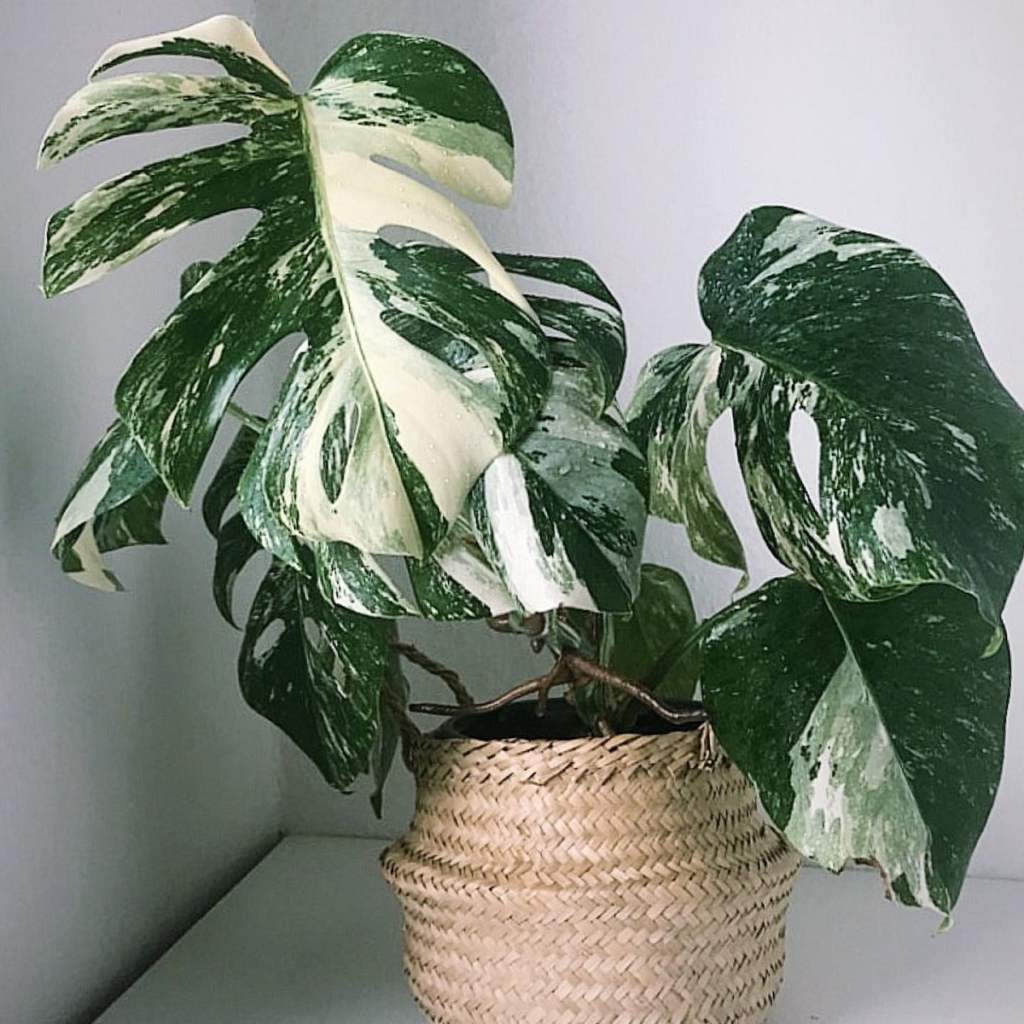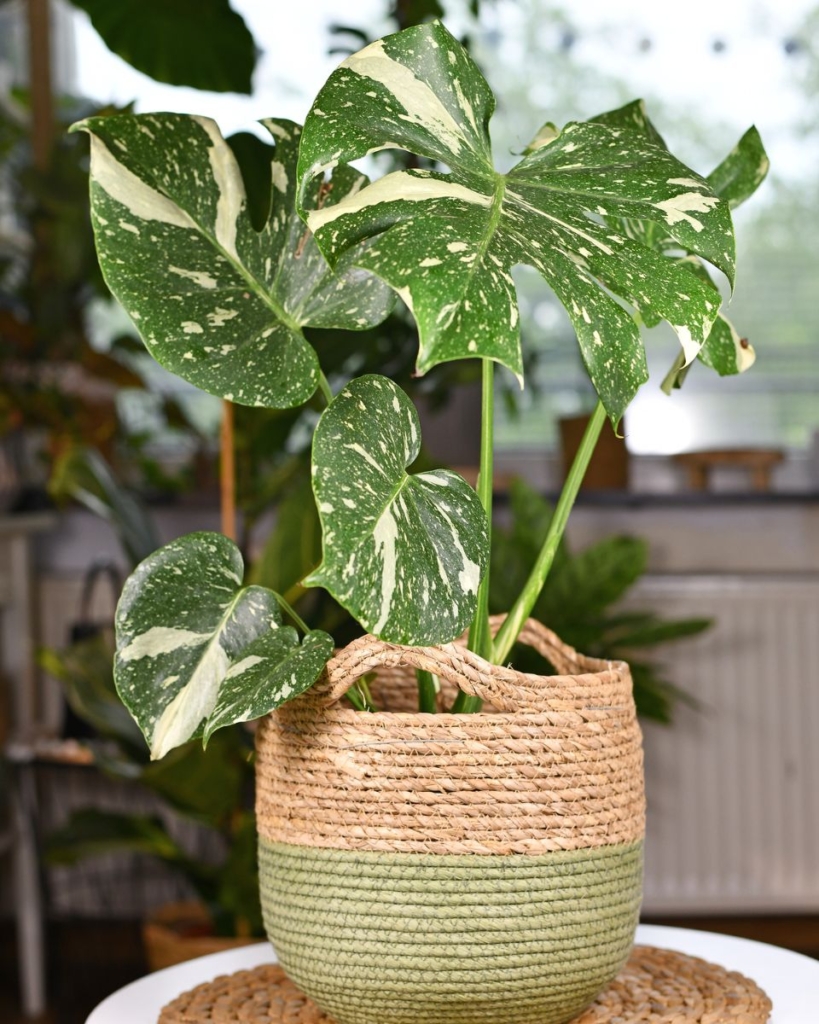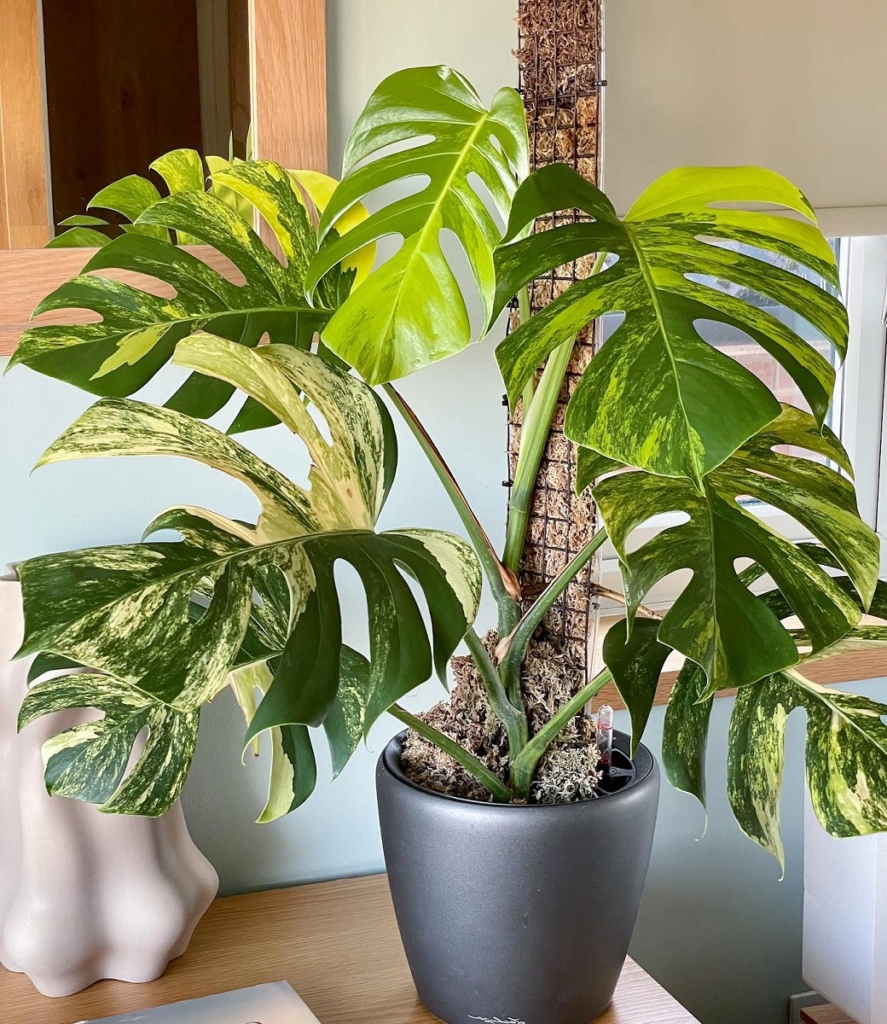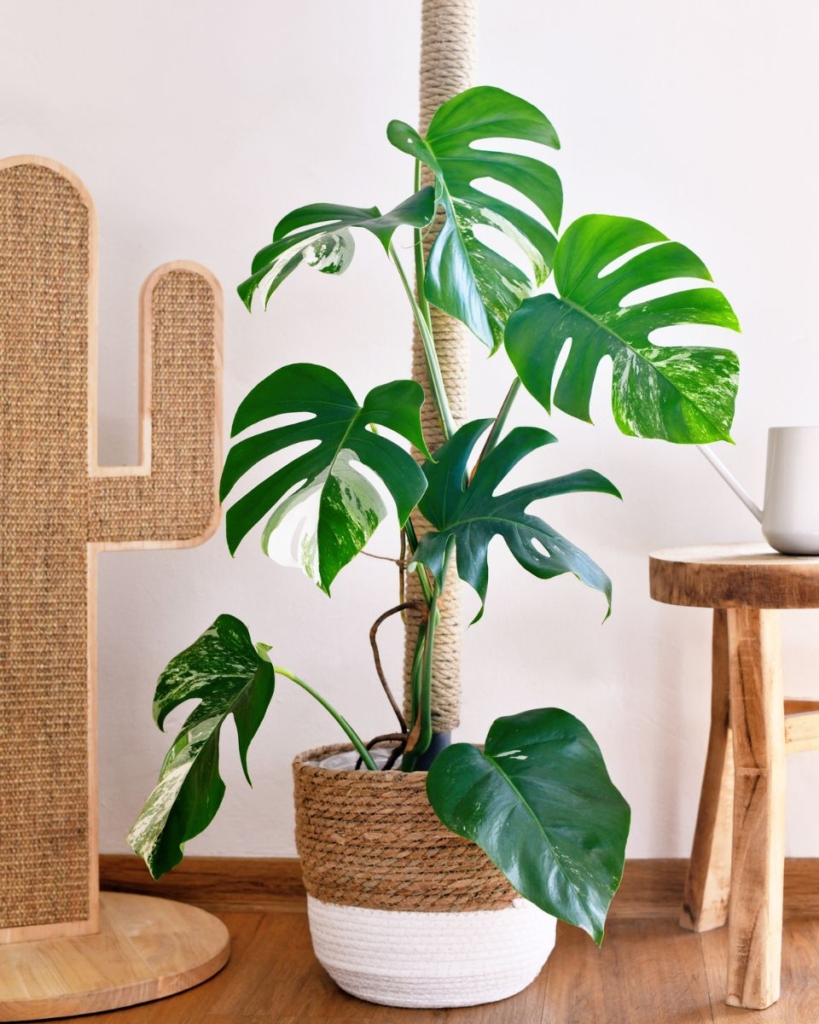Do you want to add some variety and texture to your home or garden? Variegated monstera plants are the perfect way to do this! With their large leaves, unique patterning and lush greenery, these plants make a great addition. But how do you grow them? Read on for tips on how to grow variegated monstera plants successfully so that you can create your own tropical oasis in no time.

Variegated monsteras come in many different shades of yellow, white and green—making them an eye-catching choice for any space. Plus these tropical plants are low maintenance and easy to care for. All it takes is bright indirect light and regular watering (about once a week) to keep your plant alive and healthy. Additionally, with proper pruning techniques, you can help encourage more growth over time.
When it comes down to it, growing variegated monsteras isn’t too difficult—as long as you follow the right steps. In this article, we’ll give you all the necessary information needed to achieve success with this stunning species of a houseplant! So if you’re looking for something special that will bring life into your home or outdoor area, then look no further than the beautiful variegated monstera.
Contents
What Causes Variegation In Monsteras?

Variegated plants are unique and eye-catching specimens that add a special flair to any garden. One of the varieties that can achieve this look is Monstera, but what causes variegation in them? To understand how they get their beautiful hues, it helps to take a closer look at genetic mutation and the different types of variegation.
The main cause for Monstera’s variegated leaves is due to a genetic mutation known as chimerism. This happens when two cells with different genotypes combine into one during development and results in streaks or patches of differently colored foliage on normally green plants. Another type of variegation found in some Monsteras is sectoral, which creates white edges along leaf margins from an unstable chlorophyll gene.
Popular Types Of Variegated Monstera deliciosa
Variegated Monstera deliciosa plants are a popular choice among houseplant owners. They boast gorgeous, creamy-white variegations in their leaves and bring an air of tropical sophistication to any room. These eye-catching beauties are sure to draw the attention of anyone who enters your space! There are three popular types of variegated Monstera deliciosa available: Monstera deliciosa ‘Albo Variegata’, Monstera deliciosa ‘Thai Constellation’, and Monstera deliciosa ‘Aurea’.
Monstera deliciosa ‘Albo Variegata’

This variety of Monstera deliciosa features beautiful white variegation along its leaves, making it a stunning addition to any home. The white leaves of this variety are more delicate than the standard Monstera deliciosa, and require more indirect sunlight to thrive.
Monstera deliciosa ‘Thai Constellation’

This variety of Monstera deliciosa features a unique pattern of green and cream variegation along its leaves. The cream spots on the leaves are often said to resemble a constellation of stars. This variety is hardy and can tolerate more direct sunlight than other Monstera deliciosa varieties.
Monstera deliciosa ‘Aurea’

This variety of Monstera deliciosa is an especially beautiful variation. Its leaves feature stunning green and yellow variegation, making it a truly eye-catching plant. This variety is hardy and can tolerate more direct sunlight than other Monstera deliciosa varieties.
When caring for these variegated Monstera deliciosa plants, remember they do require specific conditions to remain healthy; however, if you follow the care guidelines for each type carefully, you’ll be rewarded with lush foliage full of vibrant colors that’ll instantly upgrade any living space!
How To Grow Variegated Monstera Plants
Light Requirements
Growing variegated Monstera deliciosa is a rewarding experience as they are beautiful, vibrant plants. However, like most houseplants, there are certain considerations to make when providing the best environment for them. Light requirements should be carefully followed in order to ensure it grows well and maintains its unique coloration.
When it comes to light, variegated Monstera deliciosa does best in bright but indirect sunlight—direct sun can scorch the variegated leaves and cause fading of the colors. Placing your plant near a window that has filtered or diffused sunlight is ideal—this could mean placing curtains between the window and the plant or having an indoor spot away from any windows such as a hallway or bathroom with artificial lights.
Variegated Monstera deliciosa plants need consistent care if you want them to look their best while adding vibrancy to your space. It’s important to provide plenty of indirect light for optimal growth and color maintenance. With proper attention, you’ll soon have a colorful statement piece that adds life to any room!

Water Requirements
Watering your variegated Monstera deliciosa is the key to its success. With proper watering, you can ensure that it stays healthy and happy for many years. However, one of the most common mistakes with these plants is over-watering them—which can be detrimental to their health. Here are some tips on watering a variegated Monstera deliciosa:
First off, make sure your soil mix has good drainage properties so excess water can escape from the roots. This is essential since too much moisture can lead to root rot or other issues in the long run. Secondly, consider using pots with adequate drainage holes at the bottom for extra protection against overwatering. You could also use potting mixes specifically formulated for variegated monsteras.
Finally, when it comes time to actually water your plant, check the top inch of soil before doing so; if it feels dry then go ahead! If not, wait a couple more days until it dries out properly before giving it any more hydration. Make sure to avoid getting water around the leaves as this causes leaf spotting and discoloration—no fun!
For best results, here’s what we recommend:
- Excess Water: Keep an eye on how often you’re watering and make sure there’s enough drainage throughout your soil mix.
- Soil Mix: Choose a potting mix specifically designed for variegated monsteras or create your own blend with organic material and sand for better aeration and drainage capabilities.
- Drainage Holes: Place several small holes at the base of your container that allow excess water to drain away quickly without causing any harm to your plant’s roots.
By following these tips, you should have no trouble keeping up with all of your variegated monstera’s needs—allowing them to grow happily and healthily in no time!
Soil Requirements

Taking care of your variegated monstera plant is essential for its health and well-being. The right soil can make a huge difference in how it grows.
When potting, use fresh soil that has a mix of peat moss, perlite or vermiculite, and either bark chips or composted manure. This will help to provide the perfect balance between moisture retention and drainage. If you want to add some extra support as it grows tall over time, consider using a moss pole too!
The most important thing to remember when caring for your variegated monstera is that the soil should be moist but not soggy. Water regularly with lukewarm water and check the top layer before watering again—if there’s still moisture present then hold off until later on. With these tips in mind, you’ll have no trouble keeping your lovely plant happy and healthy!
Fertilizer Requirements
Fertilizing your variegated Monstera deliciosa is an important part of its growth. This type of houseplant needs a special kind of fertilizer that can help it to grow vibrant foliage and maintain its variegation. To ensure beautiful and healthy growth, here are the essential tips you need to know about fertilizing this unique houseplant:
First, you’ll want to use a low-nitrogen houseplant fertilizer specifically for variegated monsteras. This will provide consistent nutrients while maintaining the variegation of the plant. If you use a balanced fertilizer, the high nitrogen content can cause an overgrowth of chlorophyll and reduce the plant’s variegation.
- Potassium-rich fertilizer to help your indoor and outdoor plants develop new and healthy foliage and roots.
- No nitrogen to prevent chlorophyll overgrowth
Second, Epsom salt (also known as magnesium sulfate) is an excellent addition to a variegated Monstera plant’s fertilizer routine. It is especially beneficial for variegated Monsteras to enhance the plant’s green color. Epsom salt helps to ensure that the plant has an adequate supply of magnesium, which is essential for the production of chlorophyll. The magnesium in the salt also helps to promote healthy, lush foliage. When used in combination with a low-nitrogen fertilizer, the result is a highly variegated Monstera with a vibrant green coloration.
Third, apply once a month in spring and summer when plants are actively growing and stop applying during fall and winter when they’re dormant. You may also choose to add slow-release pellets (*affiliate link) into the potting soil at planting time as an alternative if you don’t want to manually fertilize each time.
These three steps will give your variegated monstera all the nourishment it needs for thriving growth. By following these tips, you’ll have a beautiful addition to any room in no time!
Temperature & Humidity Requirements
Caring for variegated monstera plants requires an environment with the right temperature and humidity levels. To ensure your plant is healthy, thriving and producing beautiful foliage, these two elements must be considered. Here’s what you need to know:
Firstly, a variegated monstera loves temperatures between 65-85°F (18-29°C). If temperatures are too low or high, this can cause distress to your plant and may lead to stunted growth. Secondly, it needs relatively high humidity of 60% or more—if relative air moisture drops below 50%, then misting might be necessary. Finally, keeping it away from cold drafts near windows or doors will also prevent any issues related to temperature changes.
These three steps will help make sure your variegated monstera is growing in its best possible conditions. Regularly check the temperature and humidity levels so that you can keep them within range and provide your plant with the ideal environment for flourishing health!
Pruning Variegated Monstera
Pruning variegated monstera is essential to help keep your plant healthy and thriving. It’s a great way to encourage the growth of new variegated leaves, too! During pruning, make sure that you use sharp, clean scissors or garden shears on each stem section. This will help prevent diseases from spreading throughout the entire plant.
Proper pruning techniques can provide plenty of benefits for this popular houseplant species; such as increased air circulation around foliage which helps reduce the risk of fungal diseases, promotes healthier growth patterns and shapes plants into aesthetically pleasing forms. With regular maintenance and care, you’ll have a beautiful variegated monstera plant in no time!
Pests, Diseases, And Other Problems
Taking care of a variegated monstera can be both rewarding and challenging. It’s important to stay vigilant and recognize any pests, diseases, or other problems that may arise. Loss of variegation is one issue to keep an eye on, which is often caused by too little light or high nitrogen fertilizer. Insect infestations are also common with the variegated monstera; spider mites in particular love this type of plant! Root rot is another danger—if you notice your leaves becoming yellow and droopy, check the roots for discoloration and provide extra drainage right away.
Fortunately, there are many ways to prevent these issues from occurring in the first place. Make sure your monstera gets enough sunlight but not too much direct sun exposure which could burn its delicate foliage. Regularly inspect your plant for signs of pests or disease, and prune off damaged areas promptly. Finally, always ensure proper watering practices—when in doubt err on the side of underwatering. With some consistent effort, you’ll have a happy & healthy variegated monstera thriving in no time!
How To Propagate Variegated Monstera Plants
Propagating Variegated Monstera plants is a great way to increase your collection of these unique and beautiful houseplants. Here’s how you can do it:
First, take a cutting from an existing variegated monstera plant that has aerial roots. Make sure the cutting is at least 4-6 inches long with several nodes or aerial roots on it. Then, remove any excess leaves on the bottom nodes so there are only 2 or 3 sets of leaves left below the top node.
Next, dip the bottom end of the cutting in the rooting hormone and place it in either soil or water for propagating. If using soil, use a well-draining potting mix and make sure to keep it constantly moist during propagation. On the other hand, if you’re propagating them in water, switch out the water every few days until they start developing roots.
Here are four steps to propagate variegated monstera more successfully:
- Select healthy cuttings from an established mother plant
- Dip cuttings into rooting hormones before planting
- Plant cuttings in either soil or water depending on preference
- Keep planted cuttings consistently moist until new growth appears
If all goes as planned, you should have new plants growing within weeks!
Frequently Asked Questions
Can you make your monstera variegated?
Unfortunately, it is not possible to make a monstera variegated. Variegation is the result of a genetic mutation, and while some plants can be bred to increase the chances of a mutation occurring, it cannot be guaranteed. Additionally, even if a mutation does occur, it is not possible to guarantee that it will be a variegation mutation. Therefore, the only way to get a variegated monstera would be to purchase one from a nursery or retailer that specializes in rare and unusual plants.
Can variegated Monstera be grown from seed?
Technically, variegated Monstera can be grown from seed. However, it is important to note that the variegation of the plant is not guaranteed when propagating from seed, as this trait is caused by a natural mutation and is not always passed on. Therefore, for those looking for a specific variegated Monstera plant, it is best to purchase a mature plant from a reputable nursery instead.
Does light encourage variegation?
Light can encourage variegation on variegated monstera plants by stimulating the production of white or yellow flecks in the leaves. This is because the process of variegation is caused by genetic mutations that affect the way the plant produces chlorophyll; the pigment that makes leaves green. When exposed to bright light, the variegated monstera will produce more chlorophyll in the green parts of the leaf and less in the white or yellow parts, resulting in an increased level of variegation.
On the other hand, light cannot cause variegation in non-variegated plants. This is because variegation is a genetic mutation, and light cannot cause a genetic mutation. Non-variegated monstera plants will typically respond to light in the same way, by producing more chlorophyll throughout the entire leaf and becoming greener.
Conclusion
In conclusion, growing variegated monstera can be a rewarding experience. With the right knowledge and care, you can have these beautiful plants in your home for years to come.
First of all, understand what causes variegation in monsteras; it’s not something that you can control or force. You’ll also need to know which type of variegated monstera is best suited for your environment. When caring for them, make sure to give them plenty of bright indirect light but avoid too much direct sunlight. Additionally, they require regular watering yet don’t tolerate soggy soil. Temperature and humidity levels must remain consistent as well. Pruning will help with growth and propagation is possible if done correctly. Lastly, watch out for pests and diseases that could harm your plant.
By following the steps outlined above, I’m confident that you’ll be able to successfully grow a healthy variegated monstera! All it takes is proper research and dedication—good luck!

